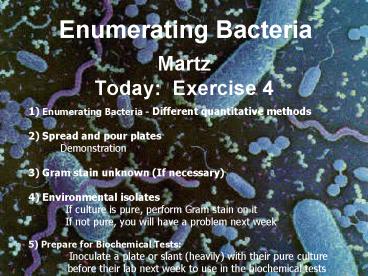Martz Today: Exercise 4 - PowerPoint PPT Presentation
1 / 17
Title:
Martz Today: Exercise 4
Description:
Inoculate a plate or slant (heavily) with their pure culture ... Coulter counter - electronic counting (this machine detects the difference in ... – PowerPoint PPT presentation
Number of Views:28
Avg rating:3.0/5.0
Title: Martz Today: Exercise 4
1
MartzToday Exercise 4
Enumerating Bacteria
1) Enumerating Bacteria - Different quantitative
methods 2) Spread and pour plates
Demonstration 3) Gram stain unknown (If
necessary) 4) Environmental
isolates If culture is pure, perform
Gram stain on it If not pure, you will have a
problem next week 5) Prepare for Biochemical
Tests Inoculate a plate or slant
(heavily) with their pure culture
before their lab next week to use in the
biochemical tests
.
2
Methods of Quantifying Bacteria
- Direct Methods
- Direct Microscope counts
- counting using a counting chamber (hemocytometer)
- Viable count assays (colony counting)
- colony counting after plating dilutions of the
sample onto growth medium - standard plate counts using spread and pour plate
techniques - (cfu for colony forming unit)
- Coulter counter - electronic counting (this
machine detects the difference in current as
individual microorganisms pass through a small
orifice) - Filtration
- Most Probable Number (mpn)
- direct cell counts and electronic cell counts
3
Methods of Quantifying Bacteria
- Indirect Methods
- Measurement of metabolic activity
- Gas or Acid Production
- Dry weight
- Turbidity using a spectrophotometer
- spectrophotometry, using a spectrophotometer
- (you will do this later when we study bacterial
growth)
4
Enumerating Bacteria
- We will use two viable count assays
- Spread plates
- A diluted sample is spread onto the surface of an
agar plate. - Pour plates
- Microorganisms are mixed with molten agar and
poured into a petri dish.
5
Serial Dilutions
- Why use Serial Dilutions?
- Bacteria undergo exponential growth, thus many
may be present in each sample - In order to count the number of bacteria, each
colony must be single and distinct - The number of countable colonies per plate is
30-300 - Serial dilutions allow one to dilute a sample
of bacteria to the point that the total number
of bacteria can be counted on an agar plate
6
How to Perform Serial Dilutions
7
Enumerating Bacteria
- 1. Label 5 culture tubes with dilutions
- (10-2, 10-3, 10-4, 10-5 and 10-6)
- 2. ASEPTICALLY, transfer 4.5ml of 0.75 NaCl to
each tube - 3. Label 5 NA (nutrient agar) plates as spread
and dilutions - (10-3, 10-4, 10-5, 10-6 and control)
- 4. Label 5 empty plates as pour and dilutions
- (10-3, 10-4, 10-5, 10-6 and control)
- 5. Pick a tube of hamburger suspension
8
Enumerating Bacteria
- 6. Record letter of sample
- 7. Make a dilution series of your sample
- Always use sterile technique
- Note the suspension is already a 10-1 dilution
- Follow the chart in your Lab Manual
- 8. Plate 0.1ml of 10-2 dilution on 10-3 spread
plate (nutrient agar) - Plating 0.1ml represents another 110 dilution,
you are actually plating 10-3
9
Enumerating Bacteria
- 9. Repeat for the rest of the spread plates
- Do NOT use the 10-6 dilution for a spread plate
- Use 0.75 NaCl for control spread plate
- 10. Add 1.0 ml of 10-3 dilution to petri dish
- 11. Add enough agar to completely cover
- bottom of plate. Mix in figure 8.
- 12. Repeat for the rest of the pour plates
- Do NOT use 10-2 dilution for a pour plate
- Let pour plates cool 15 minutes before moving
- Use 0.75 NaCl for control pour plate
10
Enumerating Bacteria
- 13. Tape plates together and incubate at room
temperature for 1 week. - 14. Next week, the plates will be counted the
results will be discussed.
11
Pour and Spread Plates
- Pour plates
- Demonstration
- Amount of agar 25ml per plate
- Figure 8
- Spread Plates
- Demonstration
- Using Hockey stick (Flame Safety)
- 20 mL EtOH
- DO NOT PICK UP THE H2O BOTTLE TO PUT THE FLAME
OUT - POTENTIALLY DANGEROUS LAB! ETHANOL FIRES MAY
OCCUR! BE SAFE AND USE PROFESSIONAL TECHNIQUE!
12
Gram Stain Unknown
- If you did not complete the Gram Stain last week,
do another Gram Stain Unknown Today!
13
Environmental IsolateDetermination of Purity
- Prepare a wet mount of your isolate and examine
under 100X w/ oil - Is there more than one organism?
- Prepare a simple stain of your isolate
- Is there more than one morphology?
- If so, you do not have a pure culture
- If not, what is the morphology of your organism?
- If your isolate is not pure, do another streak or
pick other isolate - If pure, determine storage conditions
14
Environmental Isolate
- You MUST have a fresh culture of your
environmental isolate for lab next week so that
we can perform biochemical tests!!!!
15
Determining Environmental Isolate Storage
Conditions
- Verify purity of environmental unknown
- Inoculate 2 TSA slants w/ single colony
- Store at room temperature
- Check cultures daily
- Once cultures have grown, tighten caps
- Store one slant at room temperature
- Store one slant in refrigerator-in test tube rack
16
Environmental Isolate Storage Conditions
- After 2 weeks, subculture each on to 2
- new TSA slants
- Store at room temperature
- Check cultures daily
- Which regenerates better?
- Which storage conditions are best for your
organism? - This exercise is not to determine the
temperature at which your culture grows best. - Sub-culture every week
17
Environmental Isolate Gram Stain
- Perform a gram stain of your environmental
isolate. - You MUST use a 24 hour culture for gram stains,
otherwise the results may not be accurate.































